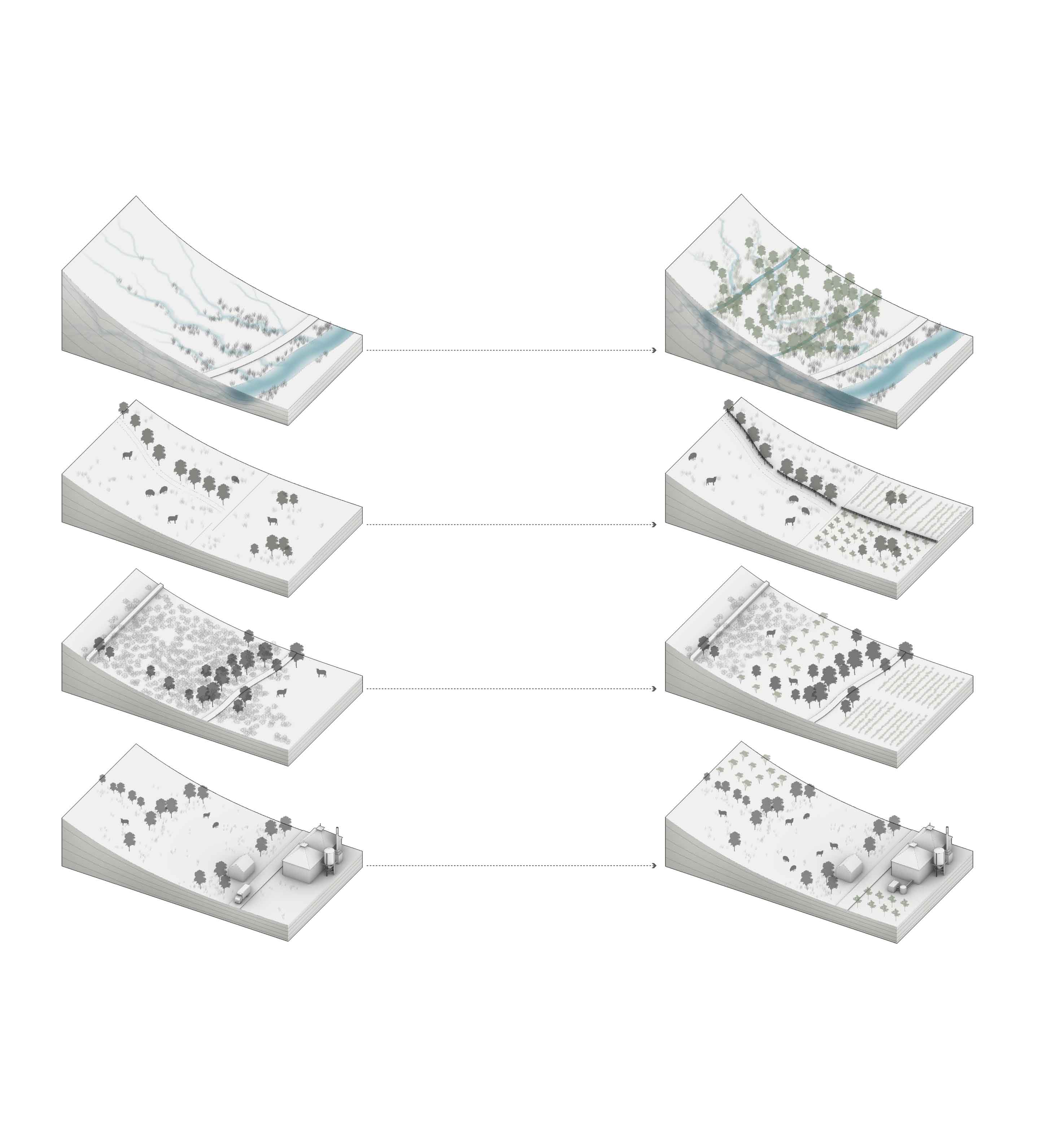- Adobe Creative Suite
- Rhino+Grasshopper
- AutoCAD
- Sketchup
- ArcGIS/QGIS
Qisen Wen


Skills & Experience
Uisge Beatha
Scotch whisky is also known as 'Uisge Beatha' in Gaelic, which means the water of life, a term that embodies an ancient understanding of the workings of nature that whisky is produced from the interaction between living and non-living elements in the landscape and contains the many features that makeup life. Whisky has played an important role in Scottish history, influencing livelihoods and shaping the landscape.

Project description
The project is located on the Isle of Arran, an essential site for whisky production and smuggling during the 18th and 19th centuries. Lochranza, the site of my project, has Arran’s first modern whisky distillery.
Arran is highly dependent on off-island energy and resources due to its low self-sufficiency in key supplies, such as food, fuels and electricity. Meanwhile, the large number of tourists has increased the seasonal shortage of resources and produced a large amount of waste that exceeds the capacity of waste treatment on the island.
The design of Whisky Township aims to establish a new and sustainable relationship between whisky production, rural life, tourism, and environmental conservation. By increasing energy efficiency, reducing resource consumption, and achieving higher levels of waste recycling, whisky township will help reduce Arran's dependence on off-island sources and reduce the impact of human activity on the environment.
Site - Lochranza
Lochranza is the northernmost village of the Isle of Arran and is home to around 200 people. Although Lochranza is located in a remote area, it has ferry lines connecting Arran with Scotland's mainland. Besides the distillery, Lochranza is also famous for its historic castle and geology study site in the coastal area.

Site Analysis & Overall Strategy







01 Land Use Strategy
The site's land can be categorised into infield, outfield and conservation area.
Infield is the main area where people live and production activities happen. Infield is also the main area for using by-products and surplus energy from the distillery.
Outfield is the peripheral production area connected to the infield, which has arable land for crop rotation, orchards, nurseries, water treatment wetlands, and tourist facilities such as golf courses and campsites.
Conservation area mainly focus on conserving natural resources such as vegetation and water, soil erosion control, groundwater restoration, and protecting wildlife habitats and ecological corridors.
The main land use strategies are upstream woodland restoration, restoration of the productive land from bracken, the development of diversified agriculture and the use of feed and fertiliser made from the by-products of whisky production.

02 Water & Vegetation Strategy
Water strategies aim to increase the town's water-carrying capacity by expanding and connecting existing artificial water bodies. New ponds and wetlands will store water for production activities and create more diverse habitats for wildlife.
Vegetation strategies aim to reduce upper stream soil erosion through woodland restoration and to link and expand existing woodlands to minimise the harmful effects of the wind while providing alternative energy and fuel source for the town. The introduction of new herbaceous, perennials and shrubs to the golf course will enhance the diversity of the forest floor and provide more and better habitats for wildlife, attracting pollinators and providing diverse landscape experiences for tourists.

03 Infrastructure Strategy
I have considered four types of infrastructure in the project, the dwelling, the production facility, the communal facility and the waste treatment facility.
Dwelling: I have introduced communal dwellings based on the form of a traditional Scottish longhouse in the project. The extra land will be transformed into a flower garden and a productive garden. The rainwater collected by the green roof will be used for daily life and watering in the garden. The garden will become a new activity space for the community and produce seasonal vegetables and fruit.
Production facility: I have introduced traditional windmills and water wheels for power generation and food processing in the project. These facilities will help produce local resources while reducing the impact on wildlife and protecting the scenery of Lochranza. I also proposed a greenhouse which uses the surplus heat from the distillery.
Public facility: I have introduced public showers using surplus heat from the distillery and a shared kitchen using biofuels such as wood, bracken, and biogas in the project. I also proposed a market that sells local products to the residents and tourists.
Waste treatment facility: Wastewater will be treated through septic tanks and constructed wetlands within the community. The localised production of daily supplies will also help reduce solid waste output.

Creating a new network that links resources, energy and waste throughout the community and landscape will increase energy efficiency, reduce resource waste, and promote waste recycling. The overall strategy will reduce the community's dependence on external resources while reducing pollutants and carbon emissions.

The Design of Whisky Township



The Model of Whisky Township






















